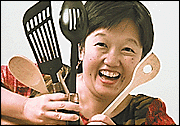Advertisement - Click to support our sponsors.


By Request

SOY flour, wheat germ and nonfat dry milk are the holy trinity of Cornell breads, developed in the Depression era to boost the nutritional value of the American bread basket. Improve bread
Cornell wayArchitect of this championship carb was Clive McCay, a professor of animal science at Cornell University in New York. He came up with his formula when asked to improve the diet of patients in New York's mental hospitals, basing it on laboratory work he'd done in the 1930s on fish, rats and dogs (he determined they lived longer and better on low-calorie diets high in minerals, vitamins and protein).
McCay's formula with its trio of additives has crept in and out of popular consciousness in the decades since. The fast-paced trade of information on the Internet has given it new life in the new millennium.
Harriet Sharp is one of those who kept one version of the McCay recipe -- an oatmeal loaf -- over the years and now seeks other ways of applying the special ingredients. She'd also like to know just how the nutritional value of these breads stacks up.
Part 1 of Sharp's inquiry -- more recipes -- is answered in "The Cornell Bread Book" (Dover Publications, 1955), compiled by McCay's wife, Jeanette McCay. The thin paperback (bargain price: $2.95) may be purchased online through www.amazon.com or may be ordered from local bookstores. It holds 54 recipes in its 27 pages.
Joanie Dobbs, the nutritionist who analyzes many Star-Bulletin recipes, is also an experienced bread-baker and seemed the right person to field the rest of Sharp's question.
Bottom line: These two Cornell Breads, the basic white and oatmeal, provide somewhat higher quantities of protein and fiber, per slice, than standard, fluffy white bread. But they are average on both counts when compared to modern wheat and grain breads.
Average protein quantity in today's whole grain breads: 3 to 4.5 grams. Fiber: 1 gram. White bread has half that. Dobbs' analysis shows the Basic Cornell bread at 3.5 g protein, 0.5 g fiber; the oatmeal at 4 g protein and 1.5 g fiber.
Dobbs also warns that the recipes are sensitive. The loaves had a tendency to fall, and took a long time to prep, thanks to the three times the dough must be set aside to rise.
The Cornell formula does offer a simple way to boost the protein content of plain flour. "Joy of Cooking" suggests this method: take your 1-cup measuring cup. Place 1 tablespoon soy flour, 1 tablespoon dry milk and 1 teaspoon wheat germ in the cup. The fill the cup with flour. Repeat for the number of cups of flour called for in any bread, cookie, muffin or cake recipe.
Basic Cornell Bread
3 cups warm water
2 tablespoons active dry yeast
2 tablespoons honey or brown sugar
3 teaspoons sea salt
2 tablespoons vegetable oil
6 cups all-purpose flour
3 tablespoons wheat germ
1/2 cup soy flour
3/4 cup nonfat dry milkPlace water, yeast, honey, salt and oil in a bowl and let stand. Stir together remaining dry ingredients.
Stir the liquid mixture, then add 1/4 to 1/2 of the flour mixture while stirring. Beat 2 minutes with electric mixer, then add remaining flour mixture. Work and mix flour in thoroughly and vigorously by hand for 5 minutes. Dough will progress from sticky to firm.
Turn onto floured board and knead, adding more flour as needed to make dough smooth. Place dough in an oiled bowl, grease top lightly and cover. Let rise in a warm place until double in size, about 1 hour.
Punch dough down, fold over edges and turn upside-down to rise another 20 minutes, or until double again.
Turn onto board and divide into 3 portions. Fold each into the center to make smooth, tight balls. Cover and let stand 10 minutes.
Shape into 3 loaves and place in oiled baking pans (8-by-4-by-2 inches). Let rise until double in size, about 45 minutes.
Bake at 350 degrees, for 50-60 minutes, until it sounds hollow when tapped. If bread begins to brown in 15 or 20 minutes, reduce temperature to 325 degrees.
Approximate nutritional information, per serving: 95 calories, 2g fat, 0.5 g saturated fat, less than 1 mg cholesterol, 200 mg sodium, 16 g carbohydrate, 0.5 g fiber, 2 g sugar, 3.5 g protein.*
John's Oatmeal Porridge Bread
3 cups boiling water
2 cups uncooked oatmeal
2 packages active dry yeast
3 tablespoons vegetable oil
1/3 cup honey, brown sugar or molasses
3 teaspoons sea salt
1/4 cup sesame seeds
1 cup raisins, dates or prunes
3 teaspoons wheat germ
1/2 cup soy flour
3/4 cup nonfat dry milk
1 cup rye, buckwheat or whole wheat flour
2-3 cups all-purpose flourCombine boiling water and oatmeal; let cool to 105 to 115 degrees. Add yeast. Stir to soften yeast. Add oil, honey, salt, sesame seeds and raisins. Stir in wheat germ, soy flour, dry milk and rye flour. Finally, stir in 2 cups all-purpose flour.
Follow directions for handling and baking dough as with the basic bread recipe, above.
Approximate nutritional information, per slice: 130 calories, 3.5 g fat, 0.5 g saturated fat, less than 1 mg cholesterol, 22 mg sodium, 22 g carbohydrates, 1.5 g fiber, 7 g sugar, 4 g protein.*
Food Stuffs: Morsels
Send queries along with name and phone number to:
By Request, Honolulu Star-Bulletin Food Section,
P.O. Box 3080, Honolulu 96802.
Or send e-mail to bshimabukuro@starbulletin.com
Asterisk (*) after nutritional analyses in the
Body & Soul section indicates calculations by
Joannie Dobbs of Exploring New Concepts,
a nutritional consulting firm.